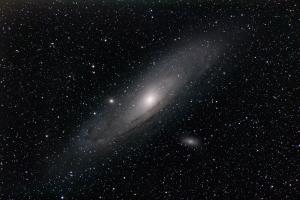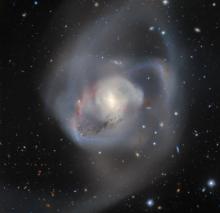M31, the Andromeda Galaxy, is the nearest giant galaxy to the Milky Way, just 2.5 million light-years away. Its size and mass are similar to the Milky Way's. It's orbited by dozens of smaller galaxies, the largest of which is M110, which looks like a small, bright blob close to the lower right of M31's center. Charles Messier discovered the smaller galaxy 250 years ago. M110 is a dwarf elliptical galaxy. It's only a fraction of the size and mass of M31. It doesn’t have spiral arms or other obvious structures, just a bright center with stars fading away toward the edges. [Torben Hansen/Wikipedia]
You are here
Messier 110
Messier 31 — the Andromeda Galaxy — is the hub of an empire. It’s orbited by at least 40 smaller galaxies, all held in place by M31’s powerful gravity.
One of its largest satellite galaxies was discovered 250 years ago today, by French astronomer Charles Messier.
Messier’s main interest was comets — hazy balls of ice and rock. At the time, finding comets brought fame and fortune. But the sky is filled with fuzzy objects that resemble comets. Messier compiled a catalog of more than a hundred of those objects so that he and others could ignore them.
While observing Messier 31 — the 31st object in his catalog — Messier found a small, bright blob next to it. He took some notes and drew a picture of it, but he didn’t list it in his catalog. Two centuries later, though, astronomers decided to add it. It became Messier 110 — the final object on Messier’s list.
M110 is a dwarf elliptical galaxy. It’s less than one-sixth the diameter of our home galaxy, the Milky Way, and only a few percent as massive. It doesn’t have spiral arms or other obvious structures — just a bright center with stars fading away toward the edges.
M31 is low in the northeast not long after darkness falls, and passes high overhead not long before dawn. Under dark skies, it’s just visible to the unaided eye as a hazy smudge of light. M110 is quite close to it, but it’s too faint to see without a telescope.
Script by Damond Benningfield
Get Premium Audio
Listen to today's episode of StarDate on the web the same day it airs in high-quality streaming audio without any extra ads or announcements. Choose a $8 one-month pass, or listen every day for a year for just $30.






